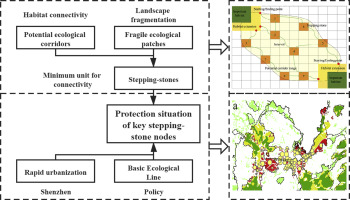当前位置:
X-MOL 学术
›
Sci. Total Environ.
›
论文详情
Our official English website, www.x-mol.net, welcomes your feedback! (Note: you will need to create a separate account there.)
Can policy maintain habitat connectivity under landscape fragmentation? A case study of Shenzhen, China.
Science of the Total Environment ( IF 9.8 ) Pub Date : 2020-01-22 , DOI: 10.1016/j.scitotenv.2020.136829 Yuhang Luo 1 , Jiansheng Wu 2 , Xiaoyu Wang 1 , Zhenyu Wang 1 , Yuhao Zhao 2
Science of the Total Environment ( IF 9.8 ) Pub Date : 2020-01-22 , DOI: 10.1016/j.scitotenv.2020.136829 Yuhang Luo 1 , Jiansheng Wu 2 , Xiaoyu Wang 1 , Zhenyu Wang 1 , Yuhao Zhao 2
Affiliation

|
The acceleration of urbanization has aggravated the fragmentation of ecological patches and increased the uncertainty risk of habitat connectivity. In the context of landscape fragmentation, government need to establish sound policies that effectively protect the stepping-stones of habitat connection and realize urban ecological integration. In this study, a circuit theory model was used to identify the potential ecological corridors in the city and corresponding stepping-stone groups, with two important stepping-stone groups selected as our areas of focus. By establishing the potential linkages between stepping-stone nodes, we constructed stepping-stone networks within the potential ecological corridors and formulated four scenarios to analyze the robustness of the stepping-stone networks under different policies. The results show that there are 46 important habitats and 22 potential ecological corridors in Shenzhen, including 22 stepping-stone networks. The most important stepping-stone network in the central Shenzhen area connects 7 important habitats and contains 110 stepping-stone nodes. The most important stepping-stone network in the northeast area of Shenzhen connects 5 important habitats and contains 130 stepping-stone nodes. Comparing the robustness and form of the stepping-stone networks under the four policy scenarios, we found that the centrality of stepping-stones is of great significance for maintaining the connectivity of important habitats. For instance, there are five stepping-stone networks in Shenzhen that have not been successfully protected by existing ecological protection policies because their highly central nodes are vulnerable to threats. This study analyzed the maintenance of habitat connectivity under different ecological protection policies in the process of urbanization and discussed the significance of highly central stepping-stone nodes in maintaining habitat connectivity. With this effort, a new perspective on habitat connectivity protection under landscape fragmentation is provided, producing a reference for the formulation of urban ecological protection policy.
更新日期:2020-01-22



























 京公网安备 11010802027423号
京公网安备 11010802027423号